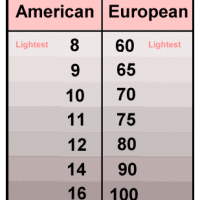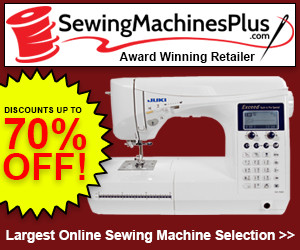Understanding Standard Sewing Machine Needles Sizes Guide
Sewing machine needle sizes are important to the quality of sewing. The needle size, needle material and needle type are all factors in making a good stitch. Needle sizes can be confusing as there are many different needle sizing systems that can vary depending on country and manufacturer.
If you are new to sewing and not aware of standard sewing machine needles sizes, then worry not. Here you will find all about different sewing machine needles sizes available. For some of us who are still beginning to use sewing machines, we might think that once the machine is properly threaded, we can start sewing away. For most part that is true especially if we use standard fabrics as prescribed by your sewing machine.
In reality however, we try out different fabrics and different projects that require more specialized stitching. We may then notice that the stitching quality isn’t the same. Some stitches may become uneven and will result to poor quality work. Some stitches may begin to unravel and you find yourself constantly going back to redo the stitches.
Sometimes these are caused by dull needles. That is one very important factor in sewing. You must have sharp needles in order to produce quality stitches. But we also have to understand that keeping our needles sharp is not the only thing we need to consider about needles. We also need to consider needle sizes for different fabrics and designs.
To Find Needle Size from the Needle Gauge
The most commonly used needle measurement system is based on the gauge length, which is the distance from the top of the head to where it enters the shank of the needle (see diagram above).
The needle size table above shows needle sizes for both Universal needle and European needle gauges. Needle sizing is determined by needle guage; needle guage is determined by needle length in millimeters (mm). Needles are sold in packages with 1 or 3 needles.
1 – Determine the needle gauge first by visually inspecting the needle gauge from either side of the needle. The needle gauge will be on one side of the package. If you cannot see it, make a mark with a pen on top of the plastic pack to locate it later.
2 – Once you have located the needle gauge, determine your country’s system then match it to that shown on our chart above. If you needle guage is a #11 and you needle system is Universal than needle size would be 75.
Universal needle gauges measure needle size from front to back – this includes both straight needles and circular needles; while European needle gauges measure from left to right – this includes only straight needles. Some manufacturers sell needles with needle gauges; however if the needle gauge is not standard, sewing machine needle sizing will need to be done on your own. In this case you can use a needle gauge tool (see diagram above).
Needle sizes are based on different threads and fabrics. The following table shows needle size recommendations for various threads and fabrics:
Fabric Thread Use Nm (#16 needle)
Universal 73 – 80 12 – 16
Wovens Cotton 60 6 – 11
Silk 55 5 – 9
Wool 60 8 – 13
Polyester 60 4 – 10
Nylon 70 7 – 14
Leather Calfskin 28 2
Metalic Stainless Steel 30 4
Wood Veneer 20-30 3
Glass Fiber 17 1.5-2
Needles come in many needle types.
The needle type is important to know when choosing needle sizes because needle types differ in their angle, number of points per needle and shape of needle eye.
Different Sewing Machine Needles Sizes
Hearing about the different sewing machine needle sizes may intimidate us to thinking that this is something that requires a higher skill set to understand. However, understanding the different needle sizes are fairly simple.
There are two standards used for needle sizes: the American and European. It’s just like understanding shoe sizes that there is a corresponding size in Europe for every American size available. For needles, the American needle sizes are from 8 to 19 with 8 being the lightest among them. There are nine different sizes namely 8, 9, 10, 11, 12, 14, 16, 18 and 19. For European needle sizes you also have nine different sizes namely 60, 65, 70, 75, 80, 90, 100, 110 and 120. The lightest needle is the size 60 needle which is also the counterpart of size 8 in American standards.
The general notion is that needle sizes range between 9-12, yet this depends on the machine type and similar factors.
Here are some general guidelines for most home sewing machines:
For decorative stitches: 0 6 8 12 16
For quilting: Q P N 1 2 3 4 5 6 7
For mending/hems: 1 2 3 4 5 6 7
For piecing: 1 2 3 4 5 6 7 8
The lightest needles are the sharpest and thinnest needles. They are used for lighter and sheerer fabrics to avoid any damage that may be caused by the thickness of the needle. The heavier needles (19/120) are used for thick fabrics that need a more-sturdy needle to avoid breaking or bending.
Different Sewing Machine Needle Types for Your Machine
On top of the different sewing machine needles sizes, there are also different sewing machine needle types for different fabrics and stitching. Some are more appropriate for intricate and complicated stitching work. Some are meant for more heavy duty sewing. The most commonly used needle types are Universal (or Ball Point Needle), Sharp, Quilting and Microtex/Milliners.
Sharp needles have a sharp point and will pierce the fabric instead of rolling on it – this creates larger needle holes. Sharp needles are recommended for use on synthetic fabrics or sewing through several layers of fabric and can be used with many different needle materials to achieve a good stitch (i.e. needle type, needle size and needle point).
The sharp point needles are used for fine fabrics to avoid any damage caused by the needle. They have to be sharp to pierce through the woven fabric and not leave any distinguishable marks. Otherwise, your needle might bend or break if it doesn’t pierce through the fabric easily. Such needles are available from the lightest needle sizes to the heaviest needle sizes.
Ball point needles on the other hand have rounder points that makes them suitable for stretch and knit fabrics. The essence of ball point needles is not to pierce through the baric but rather to push the fabric weave. This needle point type allows thicker threads to pass through needle easily without getting entangled in thick fabrics (great for sewing knits). This will avoid snagging of these kinds of fabrics when being sewed.
Universal point needles are the all-time favorite of many household sewing machine users. This primarily used in everyday general sewing works. The point is slightly rounded like in ball point needles but also tapered so that it easily cuts through woven fabrics. This allows versatility of use as it can easily pierce through any fabric even knit fabrics.
Embroidery needles have bigger eye holes to accommodate the specialty thread used for embroidery stitching. This will keep the embroidery threads from breaking and fraying. More often than not, embroidery threads are also thicker than ordinary threads.
Quilting needles have an elongated eye and blunt tip which make them useful for free-motion quilting in both hand sewing or machine stitching. Quilting needles have tapered points that allow them to sew through thick layers of fabric. Quilts are usually thick and heavy. You will need a special needle (quilting needles) to be able to work with them properly. Quilting needles are usually smaller but stronger than regular needles.
Microtex/Milliner needles have a sharp curved point which makes them useful for sewing very fine fabrics – however they should not be used through many layers as it is possible to break the needle because of the fragile needle point.
Leather Needles: For heavy duty sewing like leather and vinyl, you need a superior type of needle to allow it to pierce through the material without breaking. These are called wedge point needles. These needles can pierce through the toughest materials and also comes in various sizes. The softer kind of tough materials would require only the lighter needles.
Terms you may need to know:
Shank – The metal piece attached to the needle that fits into the needle bar. Needle size is dependent on not only its point but also its length and shaft diameter (eye). The larger needle eyes allow more space for thicker threads while maintaining durability.
Serrated Shank – Home sewing machines largely rely on serrated shanks because they create better action by self-seating into the needle bar groove.
Matching your Fabric and Needles On Your Machine
Now that you are familiar with the different available sizes and types of needle, all you need to do now is to be able to match the right needles with your fabric. An additional consideration would be the kind of stitching you need to go into your fabric.
For light and sheer fabrics, this would usually require the lighter needles as not to create a big gaping hole in the fabric once you are through stitching. While the end product may be trying to create something functional, it also has to look good aesthetically. However, as your fabrics get heavier and thicker, you have to switch to heavier needle sizes also to avoid bending or breaking your needle.
The kind of fabric is also important in choosing your needle. If the fabrics are woven, it will be more difficult to pierce through these kind of fabric. So you need the sharp point needles for these kind of fabrics. However, woven fabrics can easily be pierced or rather “pushed” aside. Here you will need rounder point needles. The idea is just to push through the knit without causing it to run.
Fabric is not your only consideration in needles however. You also have to consider the kind of stitches that you need. You may be working on a thin lightweight fabric but the thread that you will use is a heavy one as the stitch requires it. For the lightweight fabric you would have chosen a needle size that is light. However, the thread and stitch work requires a heaver sized needle. The best solution for this is to experiment with a mid-sized needle.
When testing fabric and needle compatibility, always test on a scrap fabric first before doing the actual sewing on your work. Experiments can be very successful but they can also fail at times. Save yourself the trouble of finding out the incompatibility of your fabric and needle the hard way. And always remember to practice utmost caution in handling your needles.

